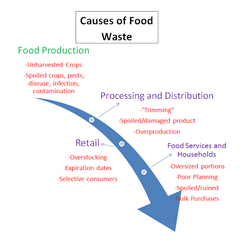Food waste

Food waste is food that is thrown away, either because it is not needed or wanted, or because it must be thrown away by law.[1][2] There are two main types of food waste:
- Food that has turned bad, for example more food was bought than was needed
- People misread dates, such as the one that says until when the food is good for as a minimum
Sources of food waste
Food production
Large amounts of food waste can occur at any stage in the process of producing food.[3] In subsistence agriculture, the amounts of food waste are unknown. Very likely, very little food is wasted, because food is produced because of a need for food. In the developed world, the food industry produces food for a global marketplace demand.[4][5]
Research has been done to see where food waste occurred. The researchers looked at the food industry of Canada and found that food was wasted at the beginning of the food production.[3] From planting, crops can be subjected to pest infestations and bad weather,[6] which cause losses before harvest.[3] Natural forces such as temperature and rainfall are the main influences on the growth of crops. For this reason, all forms of outdoor agriculture is subject to losses because of these influences.[7] The use of machinery in harvesting can cause waste, because harvesters may not see the difference between ripe and immature crops, or collect only part of a crop.[3] Food is also wasted because it does not meet certain standards or regulations for quality and appearance[8] As a result, certain crops that do not meet these standards are not harvested; left in the field, they can provide fertilizer, or food for animals.[3]
Food processing
It is unknown how much food waste occurs during food processing. When food is stored, considerable amounts are wasted because of pests and microorganisms.[9] This problem occurs in countries where it is both relatively hot, and humid. These conditions boost the growth of pests and microorganisms.[10] Extreme temperature, humidity, or microoganisms also influence the nutritional value, caloric value and edibility of crops[11] and account for food waste.[12] The "qualitative losses" are more difficult to assess than quantitative ones.[13] More losses occur because the food is not handled correctly, or because it loses weight or volume.[3][14]
It is difficult to reduce some of the food waste produced by processing without affecting the quality of the product.[15] Certain regulations concerning the safety of foods cause food to be wasted, before it even reaches the market.[16] Safety regulations are in place to protect the health of the consumer. They are very important, especially where foodstuffs of animal origin are processed. Contaminated products from these sources can lead to and are associated with microbiological and chemical hazards.[17][18]
Preventing health issues is more important than preventing food waste, or the reuse of foods that do not meet the standards.,[19]
Food Waste Media
Food recovered by food waste critic Robin Greenfield in Madison, Wisconsin, from two days of recovery from dumpsters
Lunch leftovers in a restaurant in Seoul
References
- ↑ "The Definition of Waste, Summary of European Court of Justice Judgments" (PDF). Defra. 2009. Archived from the original (PDF) on 2009-03-18. Retrieved 2009-08-20.
- "Whether it is waste must be determined ... by comparison with the definition set out in Article 1(a) of Directive 75/442, as amended by Directive 91/156, that is to say the discarding of the substance in question or the intention or requirement to discard it"
- ↑ "Council Directive 75/442/EEC of 15 July 1975 on waste". EUR-Lex. 1975. Retrieved 2009-08-20.
- "For the purposes of this Directive: (a) "waste" means any substance or object which the holder disposes of or is required to dispose of pursuant to the provisions of national law in force;" (Amended by Directive 91/156)
- ↑ 3.0 3.1 3.2 3.3 3.4 3.5 Kantor, p. 3.
- ↑ Waters, Tony (2007). The Persistence of Subsistence Agriculture: life beneath the level of the marketplace. Lexington Books. ISBN 9780739107683. Retrieved 2009-08-21.
- ↑ "Food Security". Scientific Alliance. 2009. Archived from the original on 2011-07-11. Retrieved 2009-08-21.
- "… there is certainly a lot of waste in the system … Unless, that is, we were to go back to subsistence agriculture …"
- ↑ Savary, Serge; Willocquet, Laetitia; Elazegui, Francisco A.; Castilla, Nancy P.; Teng, Paul S. (March 2000). "Rice pest constraints in tropical Asia: Quantification of yield losses due to rice pests in a range of production situations". Plant Disease. 84 (3): 357–369. doi:10.1094/PDIS.2000.84.3.357. PMID 30841254. Retrieved 2009-08-21.
- ↑
Haile, Menghestab (24 October 2005). "Weather patterns, food security and humanitarian response in sub-Saharan Africa". The Royal Society. 360 (1463): 2169–2182. doi:10.1098/rstb.2005.1746. PMC 1569582. PMID 16433102. Retrieved 2009-08-21.
- "… frequent extreme weather event such as droughts and floods that reduce agricultural outputs resulting in severe food shortages."
- ↑ "Wonky fruit & vegetables make a comeback!". European Parliament. 2009. Archived from the original on 2015-09-24. Retrieved 2009-08-21.
- ↑ Hall, p. 1.
- ↑ "Loss and waste: Do we really know what is involved?". Food and Agriculture Organization. Retrieved 2009-08-23.
- ↑ Lacey, J. (1989). "Pre- and post-harvest ecology of fungi causing spoilage of foods and other stored products". Journal of Applied Bacteriology Symposium Supplement. 18: 11S–25S. doi:10.1111/j.1365-2672.1989.tb03766.x. PMID 2508232. Retrieved 2009-08-22.[dead link]
- ↑ "Post-harvest system and food losses". Food and Agriculture Organization. Retrieved 2009-08-23.
- ↑ Kader, p. 1.
- ↑ Hall, p. 18.
- ↑ Oreopoulou, p. 3.
- ↑ Kantor, pp. 3-4.
- ↑ "Environmental, Health and Safety Guidelines for Meat Processing" (PDF). 2007: 2. Retrieved 2009-08-29.
{{cite journal}}: Cite journal requires|journal=(help) - ↑ "Specific hygiene rules for food of animal origin". Europa. 2009. Retrieved 2009-08-29.
- "Foodstuffs of animal origin … may present microbiological and chemical hazards"
- ↑ Dalzell, Janet M. (2000). Food industry and the environment in the European Union: practical issues and cost implications. Springer. p. 300. ISBN 0834217198. Retrieved 2009-08-29.








